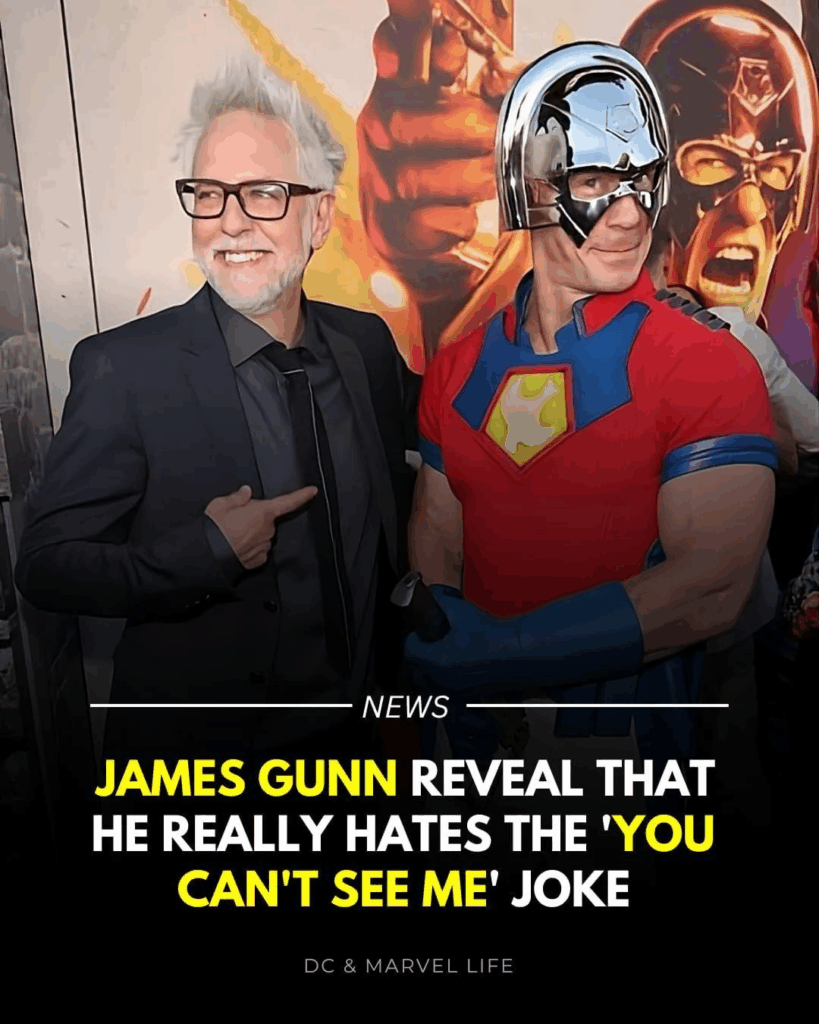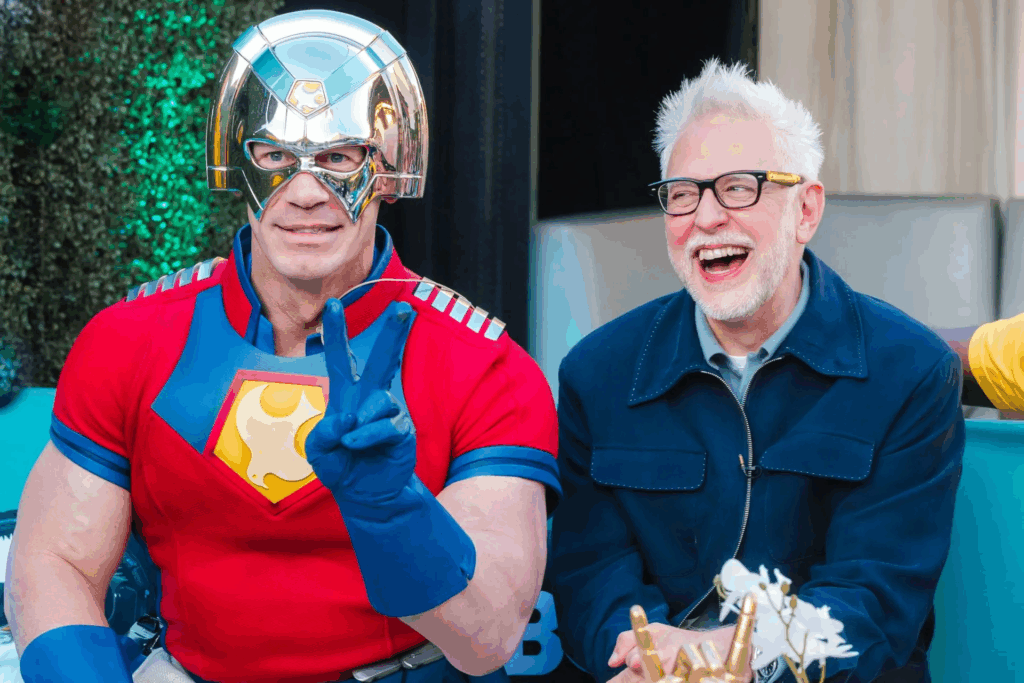f.James Gunn’s Peacemaker Season 2: A Confirmed Flop? Viewership Plunge and the DCU’s Waning Momentum.f

In the cutthroat arena of streaming superheroes, where capes clash with clickbait headlines and every episode drop is a potential ratings battlefield, James Gunn’s Peacemaker Season 2 was supposed to be the antidote to DC’s doldrums. Fresh off the heels of his directorial triumph with Superman—a film that, despite its $700 million-plus global haul, left some fans grumbling about tonal whiplash—the series returned to Max on August 21, 2025, promising more unhinged antics, interdimensional hijinks, and John Cena’s absurdly ripped vulnerability. Created, written, and helmed by Gunn himself, the show was billed as a linchpin in the rebooted DC Universe, bridging the chaotic charm of The Suicide Squad (2021) with the brighter, weirder vibes of Gunn’s Guardians playbook. Critics swooned early, awarding it a pristine 97% on Rotten Tomatoes—Gunn’s highest-rated superhero project ever—praising its “multidimensional mayhem” and “emotional gut-punches wrapped in absurdity.” Fans, too, tuned in with gusto: The premiere snagged 712,000 U.S. households in its first four days, per Samba TV data, a 22% surge over Season 1’s finale (584,000 households). It felt like vindication for Gunn’s vision—a raunchy, heartfelt romp that could anchor the DCU’s small-screen ambitions amid the wreckage of the old DCEU.

But as the eight-episode arc hurtled toward its October 10 finale, “Full Nelson,” the shine dulled faster than a Batarang in the rain. Samba TV’s latest metrics paint a grim portrait: Just 435,000 households streamed the closer in its opening four days—a 25% nosedive from Season 1’s ender and a whopping 39% erosion from Season 2’s own premiere. That’s 277,000 fewer eyeballs abandoning ship mid-voyage, a retention rate that would make even the most optimistic exec sweat. By Episode 4, the series had tumbled out of Samba’s Top 10 streaming originals, landing at a middling #16—outpaced by everything from Netflix’s Wednesday drop to HBO’s own The Penguin, which commanded 3.2 million households in its premiere window. Nielsen’s weekly charts? Radio silence. Not a single episode cracked the Top 10, a stark contrast to Season 1’s steady buzz. In an era where The Mandalorian routinely pulls 1.5 million+ for midseason lulls and The Boys spin-offs like Gen V hover around 800,000, Peacemaker‘s fade feels less like a gentle landing and more like a crash-landing in slow motion. Gunn, ever the provocateur, confirmed on October 15 that there’s no Season 3 on the horizon—a tacit admission that the numbers, not narrative whims, called the shots. “We’ve wrapped this chapter,” he posted cryptically on X, fueling speculation that Warner Bros. Discovery’s cost-cutting overlords pulled the plug. Is this the canary in the coal mine for Gunn’s DCU? Or just a bumpy sequel in a franchise built on flops and phoenixes?

To unpack the debacle, let’s rewind to the show’s improbable origins. Peacemaker Season 1, debuting January 2022 on HBO Max, was a sleeper smash amid the DCEU’s death throes. Spun from Gunn’s The Suicide Squad—a $185 million bloodbath that bombed domestically but cult-loved its way to HBO immortality—the series followed Cena’s Christopher Smith, a flag-waving vigilante with daddy issues and a helmet that doubles as a boombox. Gunn infused it with his signature DNA: Goofy ultraviolence, therapy-session heart, and a found-family vibe that turned misfits into memes. It averaged 638,000 premiere households, ending strong despite a slight dip, and snagged an Emmy for Cena’s scenery-chewing turn. Critics adored its “hilarious heresy” (94% RT), and it became Gunn’s proof-of-concept for DC’s future: irreverent, inclusive, and immune to Snyderverse sanctimony. Fast-forward three years, post-Guardians of the Galaxy Vol. 3 triumph and Gunn’s ascension to DC Studios co-CEO alongside Peter Safran. The delay wasn’t idleness; production tangled with Superman‘s 2025 juggernaut, weaving Peacemaker into its post-credits tease—Cena’s cameo as a multiversal variant hinting at canon-shattering stakes. Season 2 promised escalation: Chris grappling with an alternate utopia where his abusive father (Robert Patrick) is a saint, a multiverse rift sucking in DCU staples like Hawkman cameos, and enough R-rated romps to make Deadpool blush.

The premiere delivered on hype. Dropping Thursdays on Max, it rode Superman‘s tailwinds—Gunn timed the digital release of his Man of Steel flick to coincide, betting crossover curiosity would spike streams. And it did: That 712,000 household haul bested Season 1 benchmarks, with social buzz exploding over the opener’s “orgy of cameos” and a dance sequence that had X ablaze with Cena’s dad-bod defiance. Early episodes leaned into Gunn’s wheelhouse—Leota Adebayo (Danielle Brooks) rising as team mom, Vigilante (Freddie Stroma) unleashing feral chaos, and new blood like Frank Grillo’s grizzled Rick Flag Sr. adding gravitas. Guest spots from Superman alums (Nathan Fillion’s Guy Gardner crashing a therapy sesh) teased DCU interconnectivity, while the multiverse plot—Chris zipping between a fascist “perfect” Earth and our messy one—nodded to Loki‘s cleverness without the CGI bloat. Viewers lapped it up initially; Samba’s metrics showed a 15% bump over comparable HBO fare like And Just Like That…‘s revival. On Rotten Tomatoes, the audience score hovered at 92%, with fans raving about “Gunn’s unfiltered genius” and “Cena’s best work since wrestling.” It seemed poised to be DC’s Loki—a chaotic connector priming the pump for Lanterns and Paradise Lost.
Then, the drop-off hit like a Helm of Hate to the gut. By midseason, whispers turned to warnings. Episode 3’s extended nudity gag—a full-frontal flagellation scene that Gunn defended as “necessary satire”—sparked backlash, with X threads decrying it as “edgy for edginess’ sake.” Viewership slipped 12% week-over-week, per internal Max leaks, as casual Superman tourists bailed. Episode 4’s multiverse mechanics grew convoluted, piling on variants and retcons that demanded The Flash fluency, alienating newcomers. Samba clocked the #16 skid, while Nielsen’s omission screamed underperformer—The Penguin lapped it with 5 million cumulative households, its Gotham grit outshining Peacemaker‘s psychedelic sprawl. Gunn doubled down, tweeting defenses of the show’s “brave choices,” but fan forums festered: Reddit’s r/DC_Cinematic lit up with “overstuffed fever dream” gripes, and IMDb’s episode ratings cratered to 6.7/10 for the finale—a polarizing clusterfuck of therapy montages, a White Dragon resurrection twist, and a meta coda questioning heroism’s ROI. Audience scores dipped to 78% on RT, with reviews lamenting “stretched jokes over too many hours” and “tonal whiplash that sinks the heart.” Cena’s charisma couldn’t carry it alone; even his helmet-smashing emotional arc felt undercut by cameos that prioritized setup over payoff.
What torpedoed the momentum? Layers peel back like a bad Bat-suit. First, the Superman halo faded fast. While the film’s box office buoyed the premiere, its mixed reception—83% RT critics vs. 76% audience, dogged by “too whimsical” complaints—tainted the brand. Viewers expecting soaring heroism got multiversal malaise, a bait-and-switch that echoed The Flash‘s multiverse misfire. Streaming fatigue played a role too; 2025’s slate is a glut—Wednesday Season 2’s dual-drop devoured hours, Alien: Earth pulled 1.8 million Hulu households, and Marvel’s Agatha All Along cackled through Disney+. Peacemaker‘s weekly model, meant to build buzz, instead exposed cracks: No binge buffer for slow burns, and social media spoilers amplified gripes. Gunn’s ambition—tying loose DCEU ends while seeding DCU lore—backfired, turning episodes into homework. The finale’s “Schrödinger’s villain” ambiguity, resolving nothing on Auggie Smith’s fate, left fans howling for closure, not cliffhangers. Economically, it’s brutal: Season 2’s budget ballooned to $12 million per episode (up from $9 million), per trade whispers, banking on Superman synergy that never materialized. Max’s silence on totals—unlike Season 1’s victory laps—speaks volumes; no “most-watched Thursday comedy” boasts here.
The ripple effects? Seismic for the DCU. Gunn’s regime promised synergy—Creature Commandos (95% RT) animated a soft launch, Lanterns eyes 2026—but Peacemaker‘s flop underscores risks. No Season 3 means Cena’s arc ends unresolved, potentially shelving Flag Sr. (Grillo) and sidelining multiverse threads for Brave and the Bold. Whispers from Warner Bros. Discovery, post-The Penguin‘s triumph (HBO’s biggest DC debut since Watchmen), suggest a pivot: More grounded Elseworlds like Matt Reeves’ Gotham, less Gunn-gone-wild. X erupted with schadenfreude—”Gunn’s DCU: From hype to nope,” one viral thread jeered—while Snyder stans crowed #RestoreTheSnyderVerse. Yet defenders point to caveats: Samba tracks TV-only (ignoring mobile binges), and global Max subs (strong in Latin America) could pad totals. Gunn, undeterred, teased on his podcast that “bold swings miss sometimes,” eyeing Supergirl: Woman of Tomorrow as redemption. But with Avengers: Doomsday looming and DC’s market share lagging Marvel’s 40%, the pressure mounts.
Ultimately, Peacemaker Season 2’s saga is a cautionary comic: Hype hurls you high, but retention rules the run. It soared on novelty, crashed on complexity—a microcosm of the DCU’s growing pains. Cena’s Peacemaker remains a gem, his “dove of peace” ethos a balm in brutal times, but without sustained swarms, even the mightiest helmet can’t save the day. As Gunn soldiers on, one truth endures: In superhero streaming, the real villains are vanishing viewers. The DCU’s next chapter? Pray it packs more punch than this punchline.

